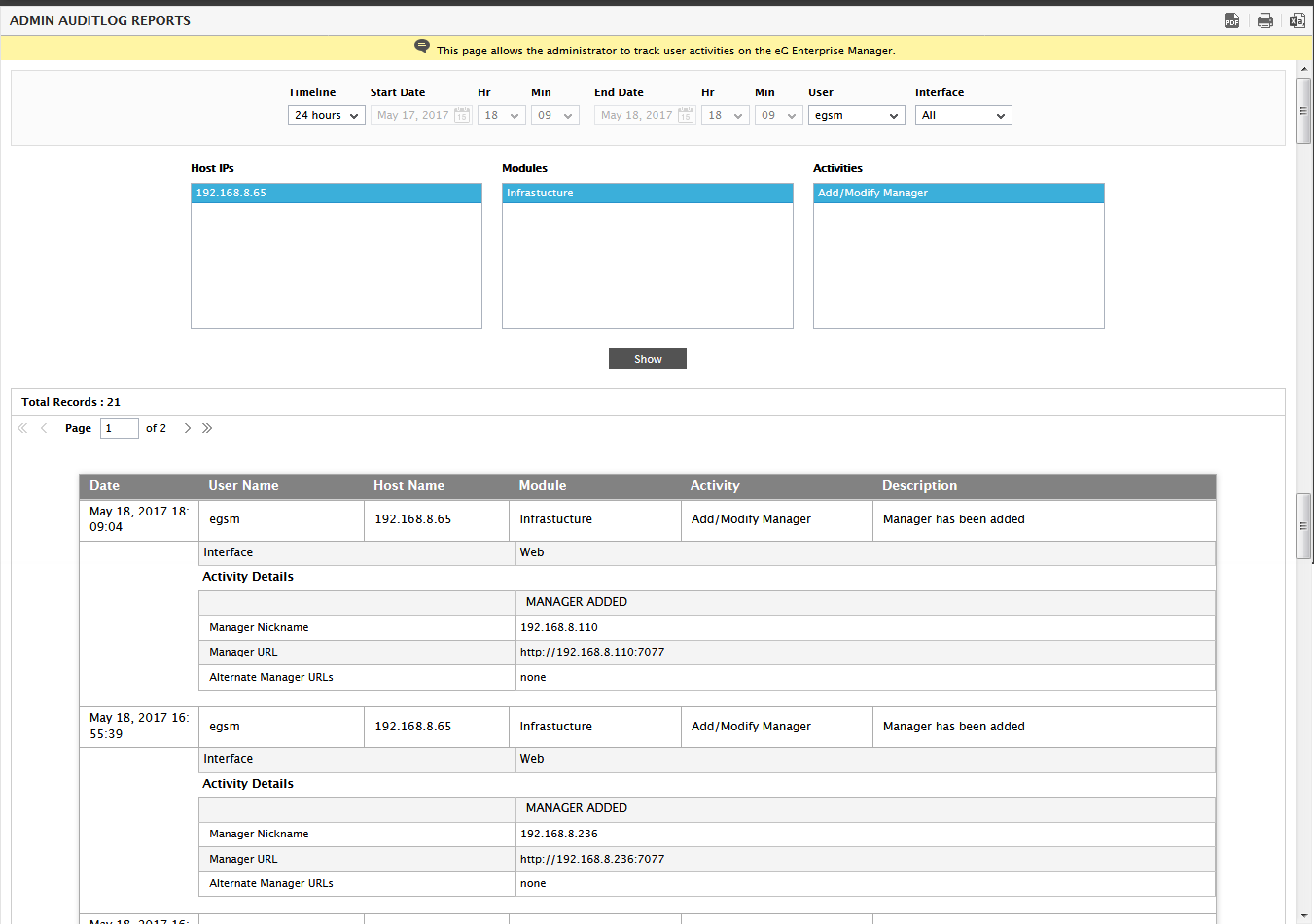Auditing Configuration Changes made using the eG SuperManager Administrative Interface
Generally, you can generate audit log reports that enable an administrator to keep tab on critical configuration changes made using the eG admin interface. These changes could be password changes, new manager additions, unmanaging a manager from the SuperManager etc., which can significantly alter the way the eG SuperManager system performs monitoring. Sometimes, these configuration changes, if not done properly or if carried out by unauthorized/unqualified personnel, can cause the eG Enterprise system to generate false alerts and perform inaccurate diagnosis.
As these AUDITLOG REPORTS reveal what admin settings were modified by which user, along with the details of the original settings, they greatly help administrators in quickly identifying and rectifying errors (if any) in configuration.
To generate the Admin related audit log reports, do the following:
-
Follow the menu sequence: Audits -> Admin. Figure 1 will then appear where you can provide the credentials to generate the report of your choice.

- In Figure 1, select a Timeline for the report. The default Timeline for the report is 24 hours. You can choose any other fixed period from the Timeline list, or select the Any option from this list. Choosing the Any timeline, allows you to provide a Start Date and End date and time for report generation. You can even choose the exact time using the Hr and Min lists.
- Next, select the User whose admin activities you want to audit. By default, the All option is displayed here, indicating that the report provides the details of all the users who have actively used the eG administrative interface till date. However, if only one user had extensively used the eG administrative interface of the SuperManager till date, then, by default, that user's name is displayed in the User list.
- By default, the report displays a maximum of 15 records per page. You can override this default setting, by specifying a different value against the Row_multiplier parameter in the [AUDIT_LOG_SETTINGS] section of the eg_ui.ini file (in the {EG_INSTALL_DIR}\manager\config directory). For instance, if 10 is specified against Row_multiplier, then this report displays 10 records per page.
- The Host IPs list displays all the IP addresses from which the chosen user(s) has accessed the eG administrative interface of the SuperManager. If you are looking for information on the admin accesses from specific IPs, select those IP addresses alone from the Host IPs list.
- After the selection, the Modules list will be populated with those admin modules that the chosen user(s) worked with while accessing the eG admin interface of the SuperManager from the selected Host IPs. If you want the details of changes that the user made in specific admin modules, select those modules alone from the Modules list.
- Based on the Modules selection, the Activities list will be populated. While working with the eG admin interface, the selected user(s) might have performed a few specific operations on the chosen Modules. eG Enterprise automatically discovers the operations that correspond to the chosen user-host IP-module combination from the audit logs, and populates the Activities list with the operations so discovered. If you want the details of specific activities only, select the required options alone from the Activities list.
-
Finally, click the Show button to generate the report. Figure 2 will then appear with the generated report.

-
The resulting report as in Figure 2 provides the following details:
- the date/time of the change
- the name of the user who made the change
- the IP address of the host from which the user accessed the eG admin interface of the SuperManager
- the module that was accessed by the user
- the specific operation/activity that was performed by the user on that module
- the interface type used - whether web interface or command line interface
- the detailed description of the change, followed by a snapshot of the settings prior to change, and the settings after the change; if a configuration has been newly introduced (for e.g., a manager has been newly managed), then only the Current Settings will be displayed.
Note:
- By default, every change record that the report displays will be accompanied by the Current and Previous configuration settings. This can sometimes clutter the report view, making it difficult for you to read and analyze the report. You can therefore hide both these columns from the report, by setting the ShowChanges parameter in the [AUDIT_LOG_SETTINGS] section of the eg_ui.ini (in the {EG_INSTALL_DIR>\manager\config directory) file to false.
- In a redundant setup, the auditlog report will have an additional MANAGER NAME column, which displays the IP or host name of the manager to which a record pertains.
- If the report runs across pages, then the Page box and the >, >>, <, and << links at the bottom of the page will aid navigation.
- You can print the report by clicking on the
 icon in Figure 2, or save the report as a PDF file by clicking on the
icon in Figure 2, or save the report as a PDF file by clicking on the  icon. You can even save the report as a CSV file by clicking on the
icon. You can even save the report as a CSV file by clicking on the  icon in Figure 2.
icon in Figure 2.